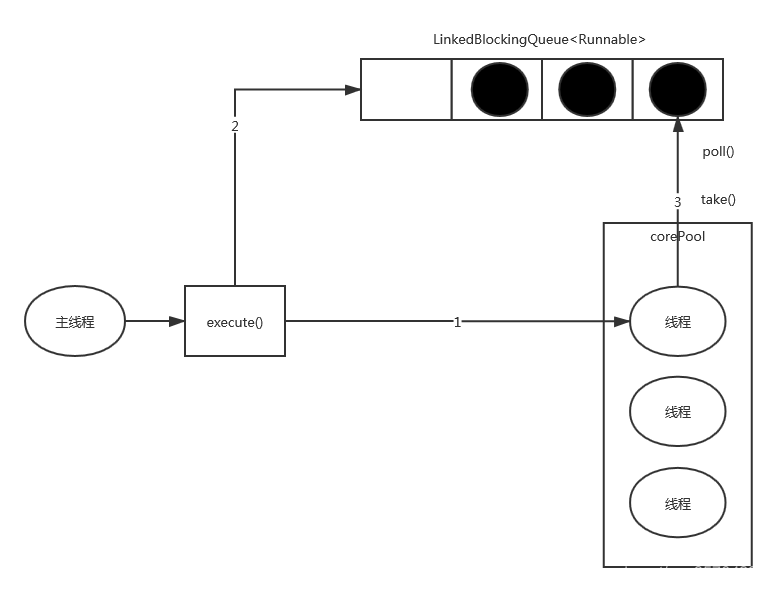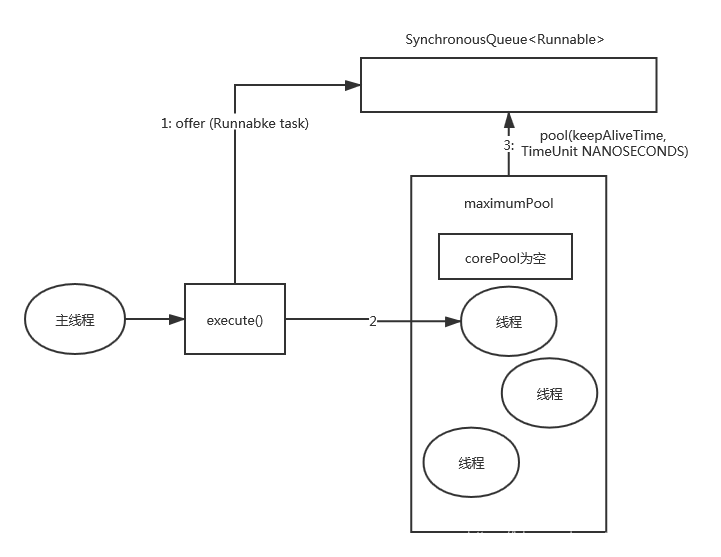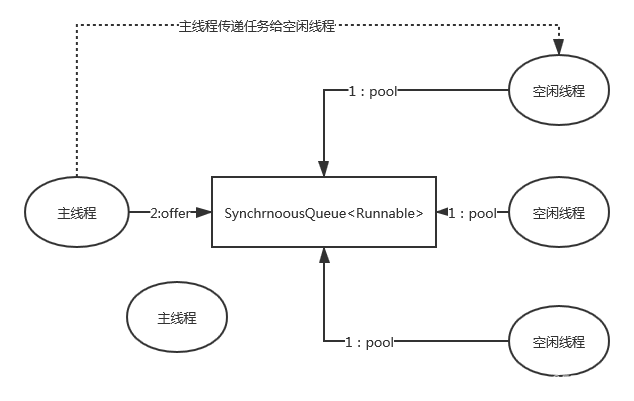ThreadPoolExecutor详解
ThreadPoolExecutor详解
Executor框架最核心的类是ThreadPoolExecutor,它是线程池的实现类,主要由下列4个组 件构成。
·corePool:核心线程池的大小。
·maximumPool:最大线程池的大小。
·BlockingQueue:用来暂时保存任务的工作队列。
·RejectedExecutionHandler:当ThreadPoolExecutor已经关闭或ThreadPoolExecutor已经饱和时(达到了最大线程池大小且工作队列已满),execute()方法将要调用的Handler。
·通过Executor框架的工具类Executors,可以创建3种类型的ThreadPoolExecutor。
·FixedThreadPool。
·SingleThreadExecutor。
·CachedThreadPool。
使用示例:
import java.io.IOException;
import java.util.concurrent.*;
import java.util.concurrent.atomic.AtomicInteger;
public class ThreadPoolExecutorTest {
public static void main(String[] args) throws IOException {
ThreadPoolExecutor executor = new ThreadPoolExecutor(2, 4, 10, TimeUnit.SECONDS,
new ArrayBlockingQueue<>(4), new NameTreadFactory(), new MyIgnorePolicy());
// 预启动所有核心线程
executor.prestartAllCoreThreads();
for (int i = 1; i <= 10; i++) {
MyTask task = new MyTask(String.valueOf(i));
executor.execute(task);
}
//阻塞主线程
System.in.read();
}
static class NameTreadFactory implements ThreadFactory {
private final AtomicInteger mThreadNum = new AtomicInteger(1);
@Override
public Thread newThread(Runnable r) {
Thread t = new Thread(r, "my-thread-" + mThreadNum.getAndIncrement());
System.out.println(t.getName() + " has been created");
return t;
}
}
public static class MyIgnorePolicy implements RejectedExecutionHandler {
@Override
public void rejectedExecution(Runnable r, ThreadPoolExecutor e) {
doLog(r, e);
}
private void doLog(Runnable r, ThreadPoolExecutor e) {
System.err.println(r.toString() + " rejected");
System.out.println("completedTaskCount: " + e.getCompletedTaskCount());
}
}
static class MyTask implements Runnable {
private String name;
public MyTask(String name) {
this.name = name;
}
@Override
public void run() {
try {
System.out.println(this.toString() + " is running!");
Thread.sleep(3000);
} catch (InterruptedException e) {
e.printStackTrace();
}
}
public String getName() {
return name;
}
@Override
public String toString() {
return "MyTask [name=" + name + "]";
}
}
}
FixedThreadPool详解
FixedThreadPool被称为可重用固定线程数的线程池。下面是FixedThreadPool的源代码实 现。
public static ExecutorService newFixedThreadPool(int nThreads) {
return new ThreadPoolExecutor(nThreads, nThreads,
0L, TimeUnit.MILLISECONDS,
new LinkedBlockingQueue<Runnable>());
}
FixedThreadPool的corePoolSize和maximumPoolSize都被设置为创建FixedThreadPool时指 定的参数nThreads。 当线程池中的线程数大于corePoolSize时,keepAliveTime为多余的空闲线程等待新任务的 最长时间,超过这个时间后多余的线程将被终止。这里把keepAliveTime设置为0L,意味着多余 的空闲线程会被立即终止。
FixedThreadPool的execute()方法的运行示意图:

1)如果当前运行的线程数少于corePoolSize,则创建新线程来执行任务。
2)在线程池完成预热之后(当前运行的线程数等于corePoolSize),将任务加入 LinkedBlockingQueue。
3)线程执行完1中的任务后,会在循环中反复从LinkedBlockingQueue获取任务来执行。
FixedThreadPool使用无界队列LinkedBlockingQueue作为线程池的工作队列(队列的容量为 Integer.MAX_VALUE)。
使用无界队列作为工作队列会对线程池带来如下影响。
1)当线程池中的线程数达到corePoolSize后,新任务将在无界队列中等待,因此线程池中 的线程数不会超过corePoolSize。`
2)由于1,使用无界队列时maximumPoolSize将是一个无效参数。`
3)由于1和2,使用无界队列时keepAliveTime将是一个无效参数。`
4)由于使用无界队列,运行中的FixedThreadPool(未执行方法shutdown()或shutdownNow())不会拒绝任务(不会调用RejectedExecutionHandler.rejectedExecution方法)。`
SingleThreadExecutor详解
SingleThreadExecutor是使用单个worker线程的Executor。下面是SingleThreadExecutor的源 代码实现。
public static ExecutorService newSingleThreadExecutor() {
return new FinalizableDelegatedExecutorService
(new ThreadPoolExecutor(1, 1,
0L, TimeUnit.MILLISECONDS,
new LinkedBlockingQueue<Runnable>()));
}
SingleThreadExecutor的corePoolSize和maximumPoolSize被设置为1。其他参数与 FixedThreadPool相同。SingleThreadExecutor使用无界队列LinkedBlockingQueue作为线程池的工 作队列(队列的容量为Integer.MAX_VALUE)。SingleThreadExecutor使用无界队列作为工作队列 对线程池带来的影响与FixedThreadPool相同,这里就不赘述了。
SingleThreadExecutor的运行示意图:

1)如果当前运行的线程数少于corePoolSize(即线程池中无运行的线程),则创建一个新线 程来执行任务。
2)在线程池完成预热之后(当前线程池中有一个运行的线程),将任务加入Linked- BlockingQueue。
3)线程执行完1中的任务后,会在一个无限循环中反复从LinkedBlockingQueue获取任务来 执行。
CachedThreadPool详解
CachedThreadPool是一个会根据需要创建新线程的线程池。下面是创建CachedThread- Pool的源代码。
在这里插入图片描述
public static ExecutorService newCachedThreadPool() {
return new ThreadPoolExecutor(0, Integer.MAX_VALUE,
60L, TimeUnit.SECONDS,
new SynchronousQueue<Runnable>());
}
CachedThreadPool的corePoolSize被设置为0,即corePool为空;maximumPoolSize被设置为 Integer.MAX_VALUE,即maximumPool是无界的。这里把keepAliveTime设置为60L,意味着 CachedThreadPool中的空闲线程等待新任务的最长时间为60秒,空闲线程超过60秒后将会被 终止。FixedThreadPool和SingleThreadExecutor使用无界队列LinkedBlockingQueue作为线程池的 工作队列。CachedThreadPool使用没有容量的SynchronousQueue作为线程池的工作队列,但 CachedThreadPool的maximumPool是无界的。这意味着,如果主线程提交任务的速度高于 maximumPool中线程处理任务的速度时,CachedThreadPool会不断创建新线程。极端情况下, CachedThreadPool会因为创建过多线程而耗尽CPU和内存资源。
CachedThreadPool的execute()方法的执行示意图:

1)首先执行SynchronousQueue.offer(Runnable task)。如果当前maximumPool中有空闲线程 正在执行SynchronousQueue.poll(keepAliveTime,TimeUnit.NANOSECONDS),那么主线程执行offer操作与空闲线程执行的poll操作配对成功,主线程把任务交给空闲线程执行,execute()方 法执行完成;否则执行下面的步骤2)。
2)当初始maximumPool为空,或者maximumPool中当前没有空闲线程时,将没有线程执行SynchronousQueue.poll(keepAliveTime,TimeUnit.NANOSECONDS)。这种情况下,步骤1)将失败。此时CachedThreadPool会创建一个新线程执行任务,execute()方法执行完成。
3)在步骤2)中新创建的线程将任务执行完后,会执行SynchronousQueue.poll(keepAliveTime,TimeUnit.NANOSECONDS)。这个poll操作会让空闲线程最多在SynchronousQueue中等待60秒钟。如果60秒钟内主线程提交了一个新任务(主线程执行步骤1)),那么这个空闲线程将执行主线程提交的新任务;否则,这个空闲线程将终止。由于空闲60秒的空闲线程会被终止,因此长时间保持空闲的CachedThreadPool不会使用任何资源。
SynchronousQueue是一个没有容量的阻塞队列。每个插入操作必须等待另一 个线程的对应移除操作,反之亦然。CachedThreadPool使用SynchronousQueue,把主线程提交的 任务传递给空闲线程执行。
CachedThreadPool中任务传递的示意图:

原文链接:https://blog.csdn.net/qq_35764295/article/details/111692211



【推荐】国内首个AI IDE,深度理解中文开发场景,立即下载体验Trae
【推荐】编程新体验,更懂你的AI,立即体验豆包MarsCode编程助手
【推荐】抖音旗下AI助手豆包,你的智能百科全书,全免费不限次数
【推荐】轻量又高性能的 SSH 工具 IShell:AI 加持,快人一步
· Manus重磅发布:全球首款通用AI代理技术深度解析与实战指南
· 被坑几百块钱后,我竟然真的恢复了删除的微信聊天记录!
· 没有Manus邀请码?试试免邀请码的MGX或者开源的OpenManus吧
· 园子的第一款AI主题卫衣上架——"HELLO! HOW CAN I ASSIST YOU TODAY
· 【自荐】一款简洁、开源的在线白板工具 Drawnix